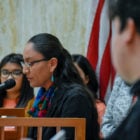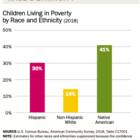Two affordable housing measures that aim to tackle a sprawling housing crisis in New Mexico are in a race against time with eight days left in the 2022 legislative session.
Currently, across the state lower-income renters grapple with a vast shortage of affordable and available rental units, homelessness ticks upward, and tenants face quick eviction proceedings in court for nonpayment of rent, according to Attorney Maria Griego in a New Mexico In Depth story published in January.
Senate Bill 134, would inject more money into the New Mexico Housing Trust Fund to bolster programs that help people around the state get into housing and create more affordable housing.
Sponsored by Sen. Nancy Rodriguez, D-Santa Fe, and Rep. Nathan P. Small, D-Las Cruces, Senate Bill 134 passed the Senate on Monday 37 to 3, and heads to the House of Representatives where it awaits a hearing in just one committee, the House Taxation and Revenue Committee.The legislation would create year-after-year revenue — called recurring in Roundhouse lingo — for the state’s Housing Trust Fund, by earmarking 2.5% of the state’s senior severance tax bond capacity allocated each year. The approximate value of the infusion would be $25 million in fiscal years 24 and 25, a significant boost over the usual annual allocation for the housing fund, which has fluctuated from $5 million this fiscal year to zero dollars in the fiscal year that ended in June 2018.
On the Senate floor, Rodriguez said that for every dollar put into the fund, it generates at least 29 to one in return. “Why is it that we have such big problems in New Mexico with affordable housing?” she asked, noting skyrocketing costs that mean many have to spend more than 50% of their income on a mortgage or rental payment and don’t have any funds left to provide for their families. “Our mental health issues, behavioral health issues, problems that are just huge in New Mexico, all are linked to somebody being homeless or the financial stresses of not being able to provide a payment for their home,” she said.
The bill received widespread endorsements on the floor from numerous legislators.
“I’d like to remind the body that all of us are one catastrophic event away from … losing the security of our homes,” said Sen. Carrie Hamblen, D-Doña Ana, who noted that she had served previously for four years as president of the board of directors of the Mesa Valley Community of Hope, a nonprofit organization that serves homeless people in Doña Ana County.
Not everyone was on board with the bill. Sen. Pat Woods, R-Broadview, objected to creating an annual appropriation.









